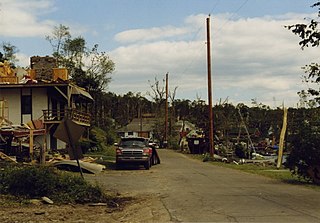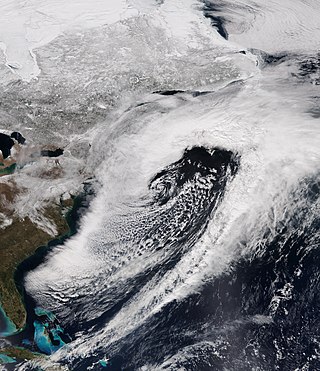
A widespread, destructive tornado outbreak affected Iowa, Kansas, Missouri, and Nebraska on April 27, 2002, and Illinois, Indiana, Kentucky, Maryland, New York, Ohio, Pennsylvania, Tennessee, Virginia, and West Virginia on the following day, April 28. Generally, tornado reports were widely scattered in each state, but significant to severe damage was noted in multiple states. Overall, 48 tornadoes were confirmed along with 6 deaths, 256 injuries, and $224 million in damage, with wind and hail adding to the damage total.

An anticyclonic tornado is a tornado which rotates in a clockwise direction in the Northern Hemisphere and a counterclockwise direction in the Southern Hemisphere. The term is a naming convention denoting the anomaly from normal rotation which is cyclonic in upwards of 98 percent of tornadoes. Many anticyclonic tornadoes are smaller and weaker than cyclonic tornadoes, forming from a different process, as either companion/satellite tornadoes or nonmesocyclonic tornadoes.

Accompanying Hurricane Katrina's catastrophic coastal impacts was a moderate tornado outbreak spawned by the cyclone's outer bands. The event spanned August 26–31, 2005, with 57 tornadoes touching down across 8 states. One person died and numerous communities suffered damage of varying degrees from central Mississippi to Pennsylvania, with Georgia sustaining record monetary damage for the month of August. Due to extreme devastation in coastal areas of Louisiana and Mississippi, multiple tornadoes may have been overlooked—overshadowed by the effects of storm surge and large-scale wind—and thus the full extent of the hurricane's tornado outbreak is uncertain. Furthermore, an indeterminate number of waterspouts likely formed throughout the life cycle of Hurricane Katrina.

A destructive and deadly tornado outbreak that took place across the Southern and Central United States from May 1 to May 3, 2008. The outbreak was responsible for at least seven fatalities and 23 injuries in Arkansas. There were at least 29 tornado reports from Iowa to Oklahoma on May 1 and 67 more in Arkansas, Missouri, Mississippi, Tennessee, Louisiana and Texas on May 2. A total of 60 tornadoes were confirmed by weather authorities.
The tornado outbreak of April 1–2, 1974, affected much of the eastern and central United States. Four fatalities and more than seventy injuries were confirmed in this outbreak. Damaging, deadly tornadoes struck Kentucky, Tennessee, and Alabama—including the Nashville and Huntsville metropolitan areas. In the latter areas, tornadoes produced F3 damage on the Fujita scale and impacted areas that would later sustain damage on April 3. Large hail and severe thunderstorm winds also impacted a broad area.

On Tuesday, June 2, 1998, one of the most significant tornado outbreaks in recent history hit the east-central United States. The severe weather event spawned a total of 33 tornadoes in nine states from New York to South Carolina and caused an estimated $40 million in damage, 77 injuries and 2 fatalities. For Pennsylvania in particular, it was the second historic and deadly severe weather outbreak in three days, as it immediately followed the late-May 1998 tornado outbreak and derecho.

The February 2016 North American winter storm was a strong winter storm that caused more than 70,000 people in southern California to lose their electricity, with many broken trees and electrical lines in that area, with the Southern Rocky Mountains having the potential to receive some of the greatest snowfall from the system. One person in San Diego, California area died when a tree fell on their car. Another person in Minnesota died after being struck by a car while crossing a street.

An unusually prolific and very destructive late-winter tornado outbreak resulted in significant damage and numerous casualties across the southern and eastern half of the United States between February 23–24, 2016. Lasting over a day and a half, the outbreak produced a total of 61 tornadoes across eleven states, which ranked it as one of the largest February tornado outbreaks in the United States on record, with only the 2008 Super Tuesday tornado outbreak having recorded more. In addition, it was also one of the largest winter tornado outbreaks overall as well. The most significant and intense tornadoes of the event were four EF3 tornadoes that struck southeastern Louisiana, Pensacola, Florida, Evergreen, Virginia, and Tappahannock, Virginia. Tornadoes were also reported in other places like Texas, Florida, and Pennsylvania. Severe thunderstorms, hail and gusty winds were also felt in the Northeastern United States and Mid-Atlantic states on February 24 as well.

Between April 28 – May 1, 2017, a series of severe weather events affected the Central United States, producing life-threatening flooding and a major tornado outbreak. It formed out of a disturbance in the Southwestern United States on April 28, and caused significant impacts, including a heavy snowstorm in the Rockies, and other types of severe weather. Up to 3 feet (36 in) of snow fell on the cold side of the system, and up to a foot of rain fell in and around the central parts of the nation.

The March 20–22, 2018 nor'easter, dubbed the "Four'easter" in some media outlets, brought additional significant late-season snowfall to the Northeastern United States, after three previous such nor'easters had struck the general region on March 1–3, 6–8, and 12–15, respectively. affected the Mid-Atlantic states and New England with over 18 in (46 cm) of heavy snow and whiteout conditions. It also affected areas of the Southeastern and Midwestern United States with both snowfall and severe weather. The nor'easter was also one of the heaviest spring snowstorms on record in some areas in the Mid-Atlantic, especially Philadelphia and New York City.

The April 2018 North American storm complex brought a wide swath of severe and winter weather that affected much of Midwest across to the East Coast of the United States. This particular outbreak led to at least 73 confirmed tornadoes over a three-day period, most of which occurred across Arkansas and Louisiana during the evening hours of April 13. The most significant tornadoes were an EF1 that caused a fatality in Red Chute, Louisiana, early on April 14, an upper-end EF2 tornado that impacted eastern sections of Greensboro, North Carolina on April 15, causing 17 injuries, and a significant EF3 tornado that impacted areas from Lynchburg to Elon, Virginia, causing severe damage and at least 10 injuries.

The March 2019 North American blizzard was a powerful Colorado Low that produced up to two feet of snow in the plains and Midwest. Rapid snowmelt following the storm caused historic flooding, and some areas received hurricane-force wind gusts. Comparable to the 1993 Storm of the Century, the storm was labeled a bomb cyclone after barometric pressure readings dropped in excess of 24 mbar (0.71 inHg) over a 24-hour period. After the storm entered Colorado from its origination in Arizona, the pressure dropped more than 30 mbar (0.89 inHg) and rapidly intensified over the western High Plains. The severe storm set new all-time record low barometric pressure readings in Colorado, Kansas and New Mexico. The storm itself killed only one person in Colorado, but flooding caused by the storm killed at least 3, one in Iowa and at least two in Nebraska and left ~140,000 without power in Texas.

The November 2020 North American storm complex was a major early-season snowstorm that impacted most of the Ohio Valley from November 30–December 2 with heavy snow, gusty winds, and near-whiteout conditions. The system originated from a weak gulf low off the coast of Texas on November 29, which began to move northeastward onto land the next day. It then began to strengthen, as well as slowing its movement down, resulting in heavy, wind-driven snow for prolonged periods of time in the Ohio Valley. It also triggered a major lake-effect snow event from December 1–2 as the system stalled over Lake Ontario, resulting in additional heavy snowfall. The storm system was also responsible for a severe thunderstorm outbreak in the Southeast and Mid-Atlantic regions, causing 22 severe thunderstorms and 5 tornadoes. In total, the system is estimated to have caused at least $100 million in damages. It was unofficially named Winter Storm Dane by The Weather Channel.

The March 2021 North American blizzard was a record-breaking blizzard in the Rocky Mountains and a significant snowstorm in the Upper Midwest that occurred in mid-March 2021. It brought Cheyenne, Wyoming their largest two-day snowfall on record, and Denver, Colorado their second-largest March snowfall on record. The storm originated from an extratropical cyclone in the northern Pacific Ocean in early March, arriving on the west coast of the United States by March 10. The storm moved into the Rocky Mountains on Saturday, March 13, dumping up to 2–3 feet (61–91 cm) of snow in some areas. It was unofficially given the name Winter Storm Xylia.

A tornado outbreak occurred on Saint Patrick's Day in the Deep South. Mississippi and Alabama were greatly affected, with numerous tornadoes being confirmed, including four that were rated EF2. Six people were injured by four different tornadoes across Alabama during the outbreak. A non-tornadic fatality also occurred due to a car crash near Natchez, Mississippi. The outbreak began the day before, with a couple tornadoes in Mississippi, and continued over the next two days. The storm moved eastward and affected portions of Florida, Georgia, the Carolinas, and Virginia on March 18, spawning more tornadoes and causing wind damage before the storms pushed offshore that night. In total, 51 tornadoes were confirmed during the event, including 25 in Alabama, making it the sixth-largest tornado event in the state's history, and is sometimes locally referred to as the Saint Patrick's Day tornado outbreak of 2021. The same areas would be hit again by a more significant and destructive tornado outbreak sequence one week later.

On December 15, a rapidly-deepening low-pressure area contributed to a historic expanse of inclement weather across the Great Plains and Midwestern United States, resulting in an unprecedented December derecho and tornado outbreak across portions of the Northern United States, a region normally affected by snow and cold weather during this time of year. Non-thunderstorm winds spurred the formation of rapidly-moving fires across Colorado and western Kansas, with attendant dust and debris spreading eastward. From central Kansas northeastward into eastern Wisconsin, the powerful derecho led to hundreds of damaging wind reports. At least 57 hurricane-force wind reports were received by the National Weather Service, signaling the most prolific wind event in the United States dating back to at least 2004. Numerous embedded circulations within this rapidly-progressing derecho produced dozens of tornadoes, including 33 that were rated EF2. The culmination of non-thunderstorm, thunderstorm, and tornadic winds caused widespread damage to structures, trees, power lines, and vehicles across the Plains and Midwest. At least 600,000 people lost power on December 15, and temperatures dropped significantly across the affected region following the event, causing accumulating snow, which hindered cleanup and recovery efforts. The storm killed at least 5 people directly, as well as 2 people indirectly through wildfires partly spawned by the storm, and caused at least $1.8 billion in damages. The number of tornadoes in this event broke a record for largest outbreak in the month of December that had been set less than a week prior. The event also became one of the largest single-day outbreaks in recorded history, with 120 tornadoes occurring over an eight-hour period.

The following is a list of weather events that occurred in 2017.

The April 2022 North American storm complex affected much of the Rocky Mountains and the Midwestern United States with tornadoes, heavy snow, and gusty winds. The system in general first began impacting the Northwest on April 11, before moving eastward into the Rocky Mountains the following day. It was also responsible for producing a large severe weather outbreak of tornadoes and damaging straight-line wind in the Midwest and South while contributing to a powerful blizzard in the upper Midwest states of North and South Dakota.






















